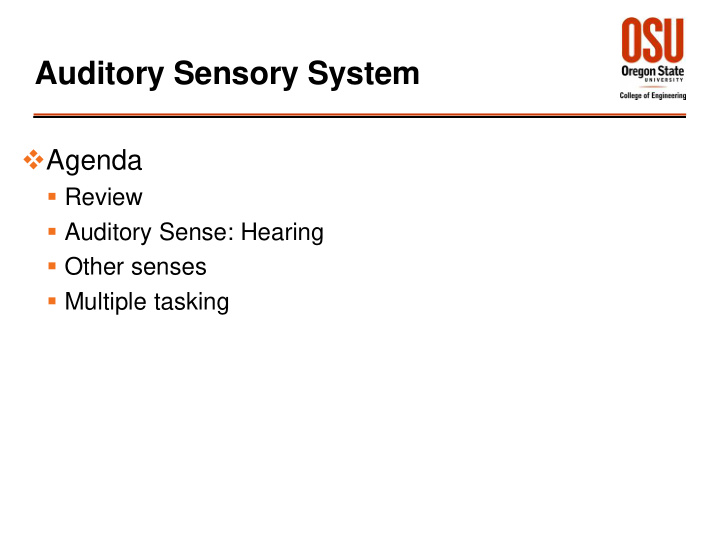



Auditory Sensory System Agenda Review Auditory Sense: Hearing Other senses Multiple tasking
Review: Visual Performance Factors affect visual performance Glare Color Individual differences Brightness Target movement Visual Angle Time available for seeing Visual Acuity Etc. Contrast Visual Field Distance/Convergence
Auditory Sense
Auditory Sense Auditory Sense Ability to hear Unlike visual stimuli, auditory does not persist in time – stays a few seconds in memory then fades. Temporal nature of sound – time patterns of intensity, frequency
Auditory Sense Sensory organ: Ear
Ear Anatomy: Outer Ear Components Pinna External auditory canal Tympanic membrane (eardrum) Functions Gather, resonate and attenuate signals based on frequency Protects the ear (wax and hairs) Converts sound pressure wave to mechanical vibration
Ear Anatomy: Middle Ear Auditory ossicles – malleus, incus, and stapes Transmit vibration to inner ear: mechanical vibration fluid-membrane wave Protect against loud and sudden noises by limiting movement of eardrum
Ear Anatomy: Middle Ear Eustachian tube Connects middle ear with throat Equalizes air pressure between middle ear and outside through the mouth
Ear Anatomy: Inner Ear - Cochlea Cochlea Fluid filled tube Basilar Membrane o Moves differently to sounds of different frequency
Ear Anatomy: Inner Ear - Corti Organ of Corti Hair cells that convert vibration into nerve impulses
Ear Anatomy
Sound Stimuli: Sound Sensed variations in air pressure o Vibrating air molecules Sound has frequency (pitch) and amplitude (loudness); usually a combination of frequencies Frequency o Range of human hearing: 20 Hz to 20,000 Hz o Highest sensitivity: 1,000 Hz - 3,000 Hz o https://www.youtube.com/watch?v=H-iCZElJ8m0 “Shape” of sound? o https://www.youtube.com/watch?v=MwsGULCvMBk
Sound Measurement Range: p < 0.001 µ bar (normal breathing) • p > 1000 µ bar (jet plane)
Sound Pressure Level (SPL) SPL = L p = 20 log 10 (p/p r ) p = RMS sound pressure of target sound p r = RMS sound pressure of reference sound (e.g. 0.0002 µ bar) SPL units: decibels (dB)
Range of Hearing
Psychophysical Scaling Loudness not directly proportional to intensity Psychophysical (perceived loudness) scales Phons o Equal loudness contours o phons = dB @ 1000 Hz Sones o Relative subjective loudness o 1 sone = 1000 Hz @ 40 dB o 2 sones = sound judged twice as loud as 1 sone sound
Psychophysical Scaling
Factors Affecting Hearing Noise Common definition: Unwanted sound Information Theory definition: o Noise is the auditory stimulus or stimuli bearing no informational relationship to the presence or completion of the immediate task
Factors Affecting Hearing Sound pressure level
Hearing Impairment Hearing loss Acoustic Trauma - immediate, organic damage from an excessive, usually sudden, exposure, such as an explosion o loss may be in conductive chain, such as rupture of eardrum or dislodging of bones in middle ear o loss may be neural, such as damage to hair cells ; this type is incurable, even with hearing aids o E.g., Explosion o Rapid pressure change
Hearing Impairment Hearing loss Temporary Threshold Shift (TTS) o Usually measured two minutes following exposure to avoid recovery o Usually most pronounced at 4000Hz Loss of birds singing o In intense noise, displacement of basilar membrane of maximum vibration is large, and hair cells are bent by considerable force o Overstimulation leads to temporary paralysis of hair cells o Recovers with time away from noise
Hearing Impairment Hearing loss Permanent Threshold Shift (PTS) o Permanent reduction in hearing sensitivity o Usually results from repeated overexposures, wherein hair cells lose their ability to recover o TTS experienced repeatedly can lead to PTS o Auditory nerve may eventually degenerate o Can also result from acoustic trauma
Hearing Impairment Hearing loss is a type of cumulative strain. Hearing loss begins with exposure to noises over 67 dB. Factors include noise level, exposure duration, gender, age, and frequency.
OSHA Standards: Continuous Noise
Noise Dosage • total (daily) dose = sum of partial doses • Requirement: total dose < 1.00
Example Worker exposed to 90 dBA for 4 hours, 105 dBA for 30 minutes. Within dosage limits?
Example Worker exposed to 90 dBA for 4 hours, 105 dBA for 30 minutes. Within dosage limits? 4 hr @ 90 dBA = 4 / 8 = 0.5 0.5 hr @ 105 dBA = 0.5 / 1 = 0.5 Total dosage = 0.5 + 0.5 = 1.0 Since 1.0 < 1.0, dosage is OK
Noise Control Source Path Receiver Design Barriers Ear plugs Maintenance Enclosures Ear muffs Mountings Baffles Mufflers
Human Senses and the Energies That Stimulate Them Adapted from Chapanis, A. (1996). Human Factors In Systems Engineering , New York: Wiley, 212. Sensation Sense Organ Stimulation Origin Sight (vision) Eye External Some electromagnetic radiation Hearing (audition) Ear Pressure variations External Rotation Semicircular canals Internal Fluid movement in inner ear Muscle stretching Muscle receptors Internal Otoliths Internal Falling, Position change of otoliths rectilinear in inner ear movement Taste Some chemical substances Specialized cells External in tongue & on mouth contact Smell external 31 Specialized cells Some vaporized in nasal cavity chemical substances
Human Senses and the Energies That Stimulate Them Adapted from Chapanis, A. (1996). Human Factors In Systems Engineering , New York: Wiley, 212. Sensation Sense Organ Stimulation Origin Touch Skin Surface deformation On contact Pressure Skin & underlying tissue Temperature Skin & underlying Temperature External on tissue change, friction, contact chemicals Pain Free nerve endings Pressure, heat, Internal or (?) cold, shock, external on chemicals contact Internal Position & Nerve endings in Muscle stretching, movement muscle, tendons, contraction, joint movement (kinesthesis joints ) 32 Mechanical vibration No specific organ Variations of skin pressure External on contact
Multiple Tasking Use of multiple resources Across Information Processing Stages (perception/cognition vs. response) Output modality (also, note that manual/spatial, Sensory vocal/verbal most compatible) Modalities (only relevant for perception stage) Input codes (relevant in WM & processing)
Multiple Tasking Use of multiple resources Modalities Visual (vision) Auditory (hearing) Codes Spatial Picture & Map Oral direction guide Verbal (text) Reading Talking & Reading aloud
Recommend
More recommend